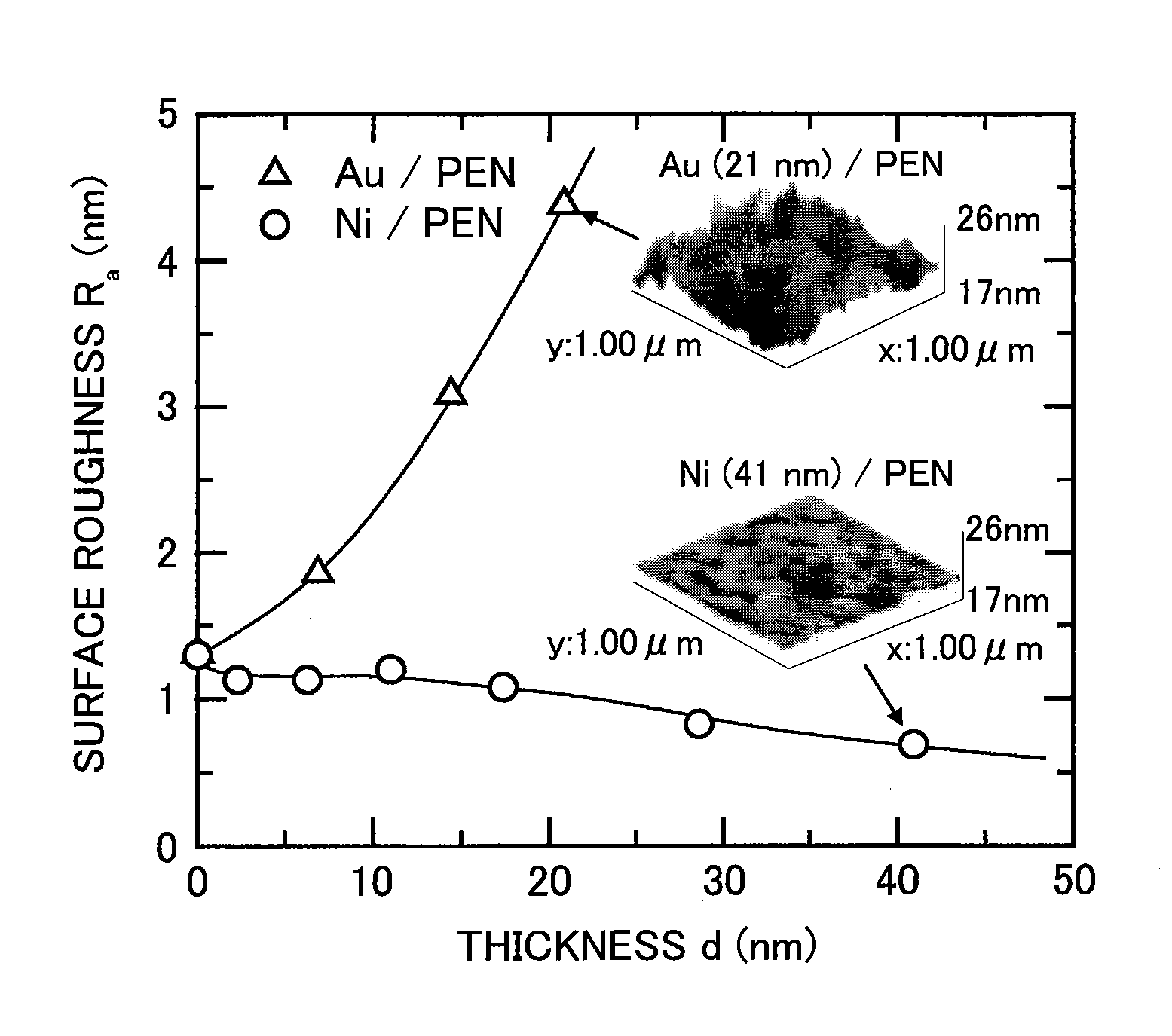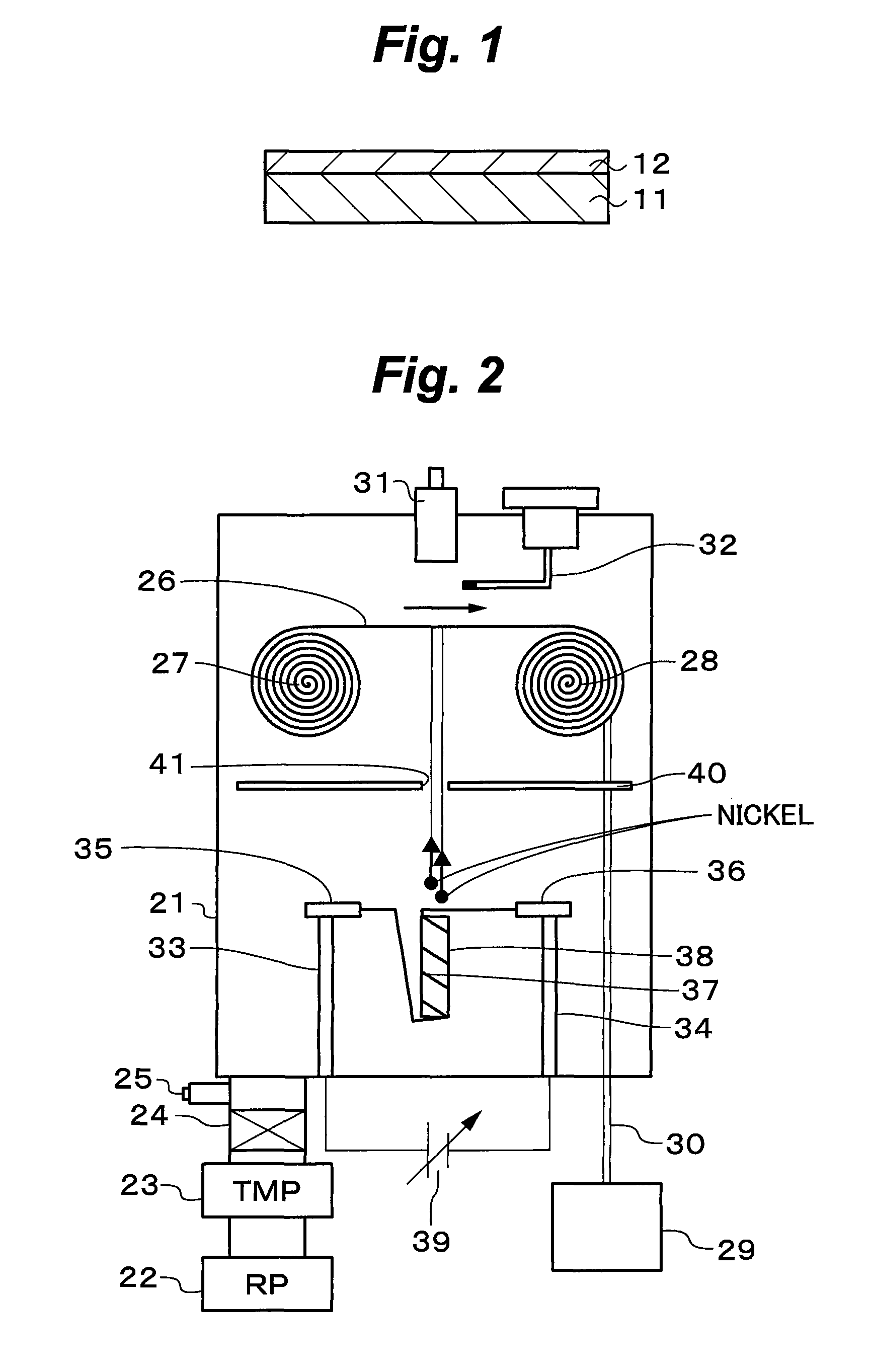Nickel thin film, method for formation of the nickel thin film, ferromagnetic nano-junction element, method for producing the ferromagnetic nano-junction element, thin metallic wire, and method for formation of the thin metallic wire
a nickel thin film and nano-junction technology, applied in the field of nickel thin film, can solve the problems of difficult to completely remove roughness on the surface of a substrate made of organic materials, and difficult to form metal thin films, and achieve the effects of small surface roughness, small surface roughness, and small surface roughness
- Summary
- Abstract
- Description
- Claims
- Application Information
AI Technical Summary
Benefits of technology
Problems solved by technology
Method used
Image
Examples
first embodiment
[0039]First, a method for formation of a nickel thin film according to the present invention is explained.
[0040]As shown in FIG. 1, in a method for formation of a nickel thin film, a nickel thin film 12 is formed on a polyethylene naphthalate substrate 11. The configuration of the polyethylene naphthalate substrate 11 is not limited, and it may be a film-like substrate, a sheet-like substrate or a bulk substrate. The vacuum evaporation method, etc. is used to form the nickel thin film 12. The temperature to form the film is, for example, room temperature.
[0041]An example is explained.
[0042]As the polyethylene naphthalate substrate 11, a PEN film (trade name: TEONEX Q65) having 5 mm width and 100 μm thickness supplied by Teijin DuPont Japan Ltd. is cut down to 2 mm width by using a slitter with the film-rolling-up system in clean environment. On the PEN film having 2 mm width and 100 μm thickness prepared by the above process, a nickel thin film 12 is formed by a vacuum evaporation m...
second embodiment
[0057]Next, a magnetoresistance effect element according to the present invention is explained. The magnetoresistance effect element is made using the ferromagnetic nano-junction of nickel thin films.
[0058]FIG. 8 shows the magnetoresistance effect element. As shown in FIG. 8, the magnetoresistance effect element is made by using two laminates each comprising the nickel thin film 12 formed on the polyethylene naphthalate substrate 11 by the same method of the first embodiment, and joining these two laminates so that the nickel thin films 12 cross to each other in such a manner that edges of these nickel thin films 12 face each other. The thickness of the nickel thin film 12 is nanometer order, preferably from one atomic layer to 10 nm. The crossing angle is 90°, for example. FIG. 9 shows the ferromagnetic nano-junction formed by joining the edges of the nickel thin films 12 each other at the cross point. In FIG. 9, the polyethylene naphthalate substrate 11 is not illustrated. In FIG....
third embodiment
[0063]Next, a method for formation of a thin metallic wire according to the present invention is explained.
[0064]According to the third embodiment, by making oblique evaporation using nickel beams by the vacuum evaporator shown in FIG. 2, a nickel thin film 12 is formed on a polyethylene naphthalate substrate 11 as shown in FIG. 1. In the oblique evaporation, the inclination of nickel beams for the major surface of the polyethylene naphthalate substrate 11 is 1 to 3°, for example.
[0065]An example is explained.
[0066]As the polyethylene naphthalate substrate 11, a PEN film (trade name: TEONEX Q65) having 5 mm width and 100 μm thick made by Teijin DuPont Japan Ltd. is used after cutting out in the predetermined shape. The nickel thin film 12 is formed on the PEN film by the oblique evaporation using nickel beams with the inclination of 1 to 3° at room temperature.
[0067]FIG. 12 shows a cross-sectional transmission electron microscope image (cross-sectional TEM image) of a sample formed ...
PUM
| Property | Measurement | Unit |
|---|---|---|
| surface roughness | aaaaa | aaaaa |
| thickness | aaaaa | aaaaa |
| thickness | aaaaa | aaaaa |
Abstract
Description
Claims
Application Information
 Login to View More
Login to View More - R&D
- Intellectual Property
- Life Sciences
- Materials
- Tech Scout
- Unparalleled Data Quality
- Higher Quality Content
- 60% Fewer Hallucinations
Browse by: Latest US Patents, China's latest patents, Technical Efficacy Thesaurus, Application Domain, Technology Topic, Popular Technical Reports.
© 2025 PatSnap. All rights reserved.Legal|Privacy policy|Modern Slavery Act Transparency Statement|Sitemap|About US| Contact US: help@patsnap.com



